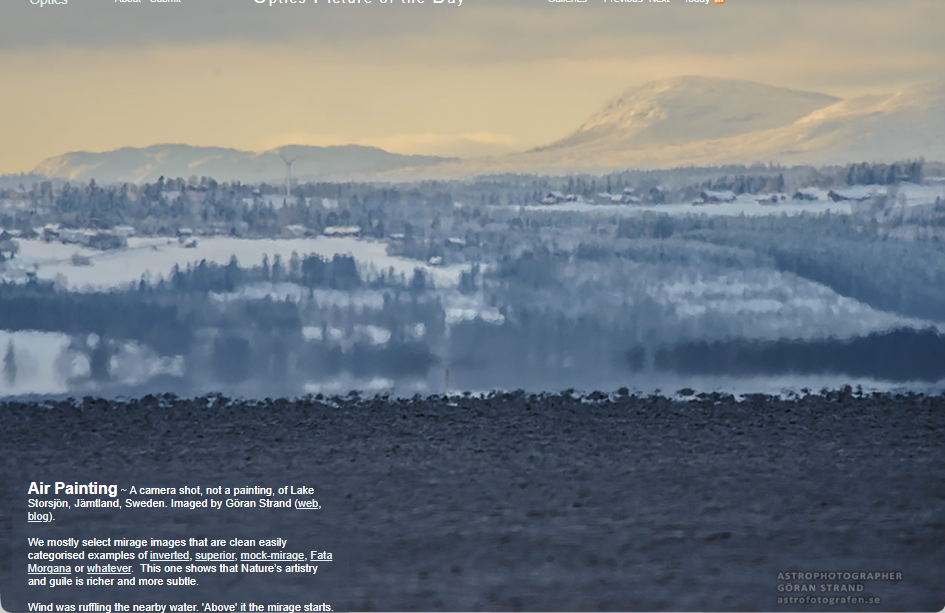Lakeside air painting - OPOD
Lakeside Air Painting: A Deeper Look into Atmospheric Optics
Have you ever come across an image that appears to be a painting, but is actually a photograph? Atmospheric optics can create captivating visual illusions that challenge our perception of reality. One such example is the mesmerizing phenomenon known as the "Lakeside Air Painting." In this article, we will delve into the intricacies of this optical phenomenon and explore the fascinating science behind it.
When we typically think of mirages, we envision the shimmering images on a distant horizon. However, the Lakeside Air Painting showcases the complexity and subtlety of Nature's artistry. Captured by photographer Göran Strand in Jämtland, Sweden, this image reveals a mirage that is not just a simple reflection, but a composition of multiple layers and illusions.
The scene unfolds with the wind gently ruffling the surface of the nearby lake. Just above the water, the mirage begins. Contrary to what one might expect, the apparent reflection of the far lake shore and its lower trees in the smooth water is nothing more than an illusion. This inverted part of the mirage is classified as an "inferior" mirage, where warmer air beneath cooler air creates a distorted image below the real objects.
However, what truly captivates the viewer is what lies above this inverted image. There are hints of at least two superimposed images, creating a captivating "blobbyness" that resembles a watercolor painting. The landscape above these layers settles into a snow-covered village in a clearing, yet the turbulence and resulting refraction persist, adding an ethereal quality to the overall composition.
To understand this phenomenon better, let's break down the key elements at play:
-
Turbulence: The distortion and mixing of air layers create a visual effect akin to brush strokes in a watercolor painting. This turbulence adds depth and complexity to the mirage, making it appear more like a work of art than a mere reflection.
-
Inferior Mirage: The distant lake shore is imaged below the real shore due to the temperature difference between the air near the lake surface and the air higher up. This inverted image gives the false appearance of smooth water and a nearby lake shore.
-
Temperature Gradient: The temperature difference between the layers of air causes light rays to bend, creating the illusion of reflection where none exists. The warmer air near the surface refracts light differently than the cooler air above, distorting the image seen by an observer.
The Lakeside Air Painting exemplifies the captivating beauty and complexity of atmospheric optics. It reminds us that nature's artistry extends far beyond what meets the eye at first glance. Through the interplay of temperature gradients, turbulence, and refraction, an ordinary lakeside scene is transformed into a mesmerizing masterpiece.
As with any optical phenomenon, it is essential to approach such images with curiosity and an open mind. The complexities of atmospheric optics can sometimes blur the lines between reality and illusion, challenging our perception of the world around us. The Lakeside Air Painting serves as a reminder to appreciate the wonders of nature and its ability to surprise and captivate us.
In conclusion, the Lakeside Air Painting is a remarkable example of atmospheric optics that showcases the intricate interplay between temperature gradients, turbulence, and refraction. By understanding the science behind this phenomenon, we can gain a deeper appreciation for the complexities of our natural world. So next time you come across an image that appears too extraordinary to be real, remember that sometimes, reality can be even more fascinating than fiction.

Air Painting ~ A camera shot, not a painting, of Lake Storsjön, Jämtland, Sweden. Imaged by Göran Strand (web, blog).
We mostly select mirage images that are clean easily categorised examples of inverted, superior, mock-mirage, Fata Morgana or whatever. This one shows that Nature’s artistry and guile is richer and more subtle.
Wind was ruffling the nearby water. 'Above' it the mirage starts. Not a near shoreline, a mirage. The far lake shore and its lower trees are apparently reflected in smooth water. That is an illusion. The inverted part is an ‘inferior’ mirage (image below the real objects) made by warmer air below cooler.
What is happening above the immediate inverted image is strange. There are hints of at least two superimposed images. There is a beguiling blobbyness that could be mistaken for a watercolour painting.
Above the double vision layer the landscape settles. There is a snow covered village in a clearing. Yet the blobbyness from some kind of turbulence and resulting refraction persists.
Image ©G�ran Strand, shown with permission

Turbulence creates a strange blobby watercolour brush stroke appearance
Inferior mirage, the distant lake shore is imaged inverted and below the real shore.
Air near the lake surface is warmer than that higher up.
The mirage edge gives the false appearance of smooth water and a nearby lake shore.
Note: this article has been automatically converted from the old site and may not appear as intended. You can find the original article here.
Reference Atmospheric Optics
If you use any of the definitions, information, or data presented on Atmospheric Optics, please copy the link or reference below to properly credit us as the reference source. Thank you!
-
<a href="https://atoptics.co.uk/blog/lakeside-air-painting-opod/">Lakeside air painting - OPOD</a>
-
"Lakeside air painting - OPOD". Atmospheric Optics. Accessed on November 26, 2024. https://atoptics.co.uk/blog/lakeside-air-painting-opod/.
-
"Lakeside air painting - OPOD". Atmospheric Optics, https://atoptics.co.uk/blog/lakeside-air-painting-opod/. Accessed 26 November, 2024
-
Lakeside air painting - OPOD. Atmospheric Optics. Retrieved from https://atoptics.co.uk/blog/lakeside-air-painting-opod/.